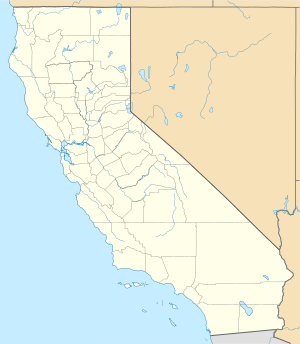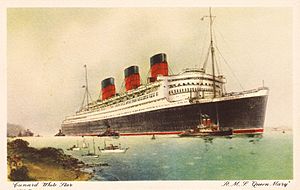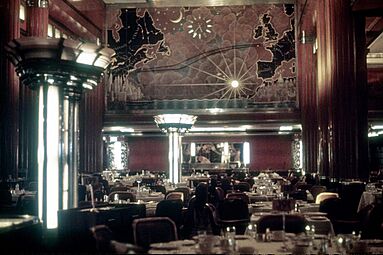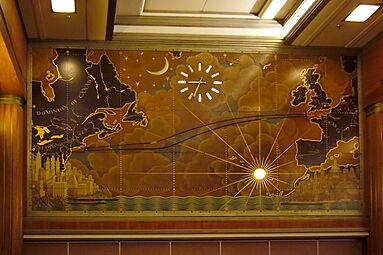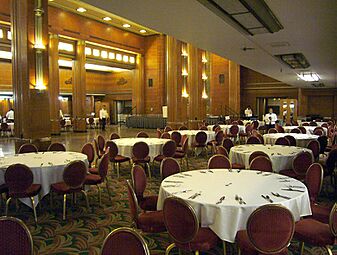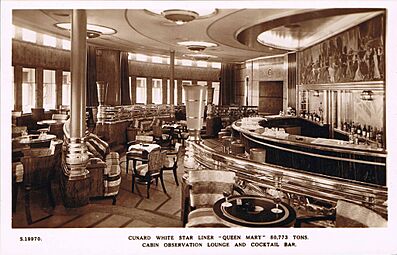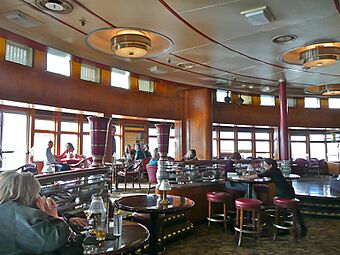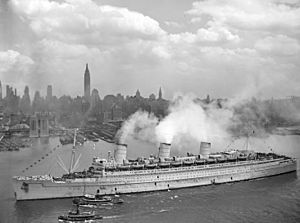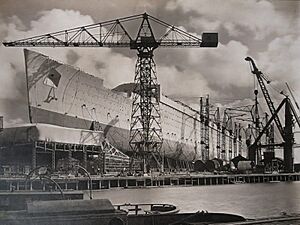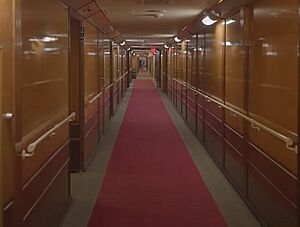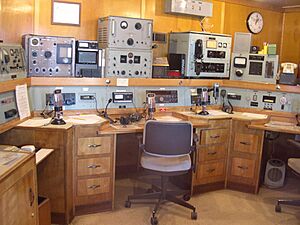RMS Queen Mary facts for kids
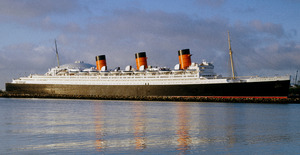
Queen Mary at Long Beach, California
|
|
| History | |
|---|---|
| Name | Queen Mary |
| Namesake | Mary, Queen of the United Kingdom |
| Owner |
|
| Port of registry | Liverpool |
| Route | Southampton to New York via Cherbourg (eastbound and westbound) Southampton to Halifax, Nova Scotia via Halifax (eastbound and westbound) |
| Ordered | 3 April 1929 |
| Builder |
|
| Yard number | 534 |
| Laid down | 1 December 1930 |
| Launched | 26 September 1934 |
| Sponsored by | Queen Mary |
| Christened | 26 September 1934 |
| Maiden voyage | 27 May 1936 |
| In service | 1936–1967 |
| Out of service | 9 December 1967 |
| Identification |
|
| Status | Laid up as a floating hotel and museum ship, Long Beach. |
| General characteristics | |
| Type | Ocean liner |
| Tonnage |
|
| Displacement | 77,400 long tons (78,642 metric tons) |
| Length |
|
| Beam | 118 ft (36.0 m) |
| Height | 181 ft (55.2 m) |
| Draught | 38 ft 9 in (11.8 m) |
| Decks | 12 |
| Installed power | 24 × Yarrow boilers |
| Propulsion |
|
| Speed |
|
| Capacity | 2,140 passengers: 776 first (cabin) class, 785 cabin (tourist) class, 579 tourist (third) class |
| Crew | 1,100 |
|
RMS Queen Mary
|
|
| NRHP reference No. | 92001714 |
| Added to NRHP | 15 April 1993 |
The RMS Queen Mary is a famous British ocean liner that sailed across the North Atlantic Ocean from 1936 to 1967. It was built for the Cunard Line and was known for its speed and luxury. Today, the Queen Mary is a floating hotel, museum, and event space in Long Beach, California, United States. It is recognized as a historic place and is part of the Historic Hotels of America.
Built in Clydebank, Scotland, the Queen Mary was designed to be one of the fastest and largest ships in the world. It often sailed alongside its sister ship, the RMS Queen Elizabeth, offering weekly trips between Southampton, Cherbourg, and New York. These "Queens" were Britain's answer to the huge ocean liners built by other countries during that time.
The Queen Mary made its first journey on May 27, 1936. It quickly won the Blue Riband award for the fastest Atlantic crossing. During World War II, it became a troopship, carrying thousands of Allied soldiers. At one point, it carried over 16,600 people, which is still a record for a single ship.
After the war, the Queen Mary went back to carrying passengers. However, with the rise of jet aircraft in the 1950s, fewer people chose to travel by ship. The Queen Mary became too old and expensive to run. In 1967, it was retired from service and bought by the City of Long Beach. It sailed to Long Beach and has been a popular attraction ever since.
Contents
Building a Giant Ship: The Queen Mary's Story
In the late 1920s and early 1930s, countries like Germany, Italy, and France were building huge, fast ocean liners. Britain wanted to keep up. The White Star Line started building a ship called Oceanic, and the Cunard Line planned its own large ship.
Construction on Cunard's ship, known as "Hull Number 534," began in December 1930 in Clydebank, Scotland. However, work stopped in December 1931 because of the Great Depression, a time when money was very scarce. Cunard asked the British government for a loan to finish the ship. The government agreed, but only if Cunard merged with the White Star Line. This led to the creation of the Cunard-White Star Line in 1934.
Work on Hull 534 started again, and the River Clyde had to be made deeper and wider to handle the ship's massive size. On September 26, 1934, Queen Mary herself launched the ship, officially naming it the RMS Queen Mary. The name was a secret until the launch. Cunard had planned to name it Victoria, but King George V joked that his wife, Queen Mary, would be pleased if it was named after her.
After its launch, workers spent a lot of time fitting out the Queen Mary. It had 24 powerful boilers and four huge turbines that gave it a top speed of over 32 knots (about 37 miles per hour). The ship was 1,019.4 ft (310.7 m) long and weighed 80,774 gross register tons (GRT) tons, making it the world's largest passenger ship at the time. Building the Queen Mary took three and a half years and cost a lot of money.
Sailing the Seas: Before World War II
The Queen Mary began its first journey from Southampton on May 27, 1936, led by Captain Sir Edgar Britten. It sailed quickly across the Atlantic, arriving in New York Harbor on June 1, 1936.
Some people thought the Queen Mary's design was a bit old-fashioned compared to its French rival, the Normandie, which had a very modern look. However, the Queen Mary quickly became more popular with passengers.
In August 1936, the Queen Mary won the Blue Riband for the fastest Atlantic crossing. It lost the title to Normandie in 1937 but won it back in 1938. The Queen Mary's record stood until 1952, when the new SS United States claimed it.
Life Aboard: Inside the Queen Mary
The inside of the Queen Mary was designed by Arthur Joseph Davis and Benjamin Wistar Morris. It featured a stylish Art Deco design. The ship had many amazing facilities for its passengers. These included two indoor swimming pools, beauty salons, libraries, and special nurseries for children. There was even a music studio, a lecture hall, and outdoor paddle tennis courts. Passengers could also use dog kennels for their pets!
The largest room on board was the main dining room for first-class passengers, which was three stories tall. A special mural in this room showed a map of the Atlantic crossing. A small model of the Queen Mary would move along the map to show the ship's progress.
For a more private meal, first-class passengers could visit the Verandah Grill. This fancy restaurant could seat about eighty people and turned into the Starlight Club at night. The Observation Bar was another popular spot, offering wide views of the ocean. The ship used different types of wood from across the British Empire to decorate its rooms.
- Queen Mary Art Deco Interiors
The Grey Ghost: Queen Mary in World War II
In August 1939, as World War II was about to begin, the Queen Mary was sailing back to Southampton. It was escorted by a warship to keep it safe. When it arrived in New York on September 1, war had been declared, and the ship was told to stay in port.
In March 1940, the Queen Mary was joined in New York by its new sister ship, the Queen Elizabeth. Soon after, the Queen Mary sailed to Sydney, Australia, where it was turned into a troopship. This meant it would carry soldiers from Australia and New Zealand to the United Kingdom.
The ship's hull, upper parts, and funnels were painted navy grey. Because of this new color and its incredible speed, it became known as the "Grey Ghost." To protect against magnetic mines, a special coil was added around the outside of the hull. Inside, all the fancy furniture and decorations were removed and replaced with simple wooden bunks for soldiers.
The Queen Mary and Queen Elizabeth were the largest and fastest troopships in the war. They often carried as many as 15,000 soldiers on a single trip, usually traveling alone without escorts. Their high speed and zigzag movements made it almost impossible for German U-boats to catch them. In fact, Adolf Hitler offered a huge reward to any U-boat captain who could sink either ship.
On October 2, 1942, the Queen Mary was involved in an accident off the Irish coast. It accidentally collided with one of its escort ships, the light cruiser HMS Curacoa, causing it to sink. Sadly, 338 lives were lost. The Queen Mary was carrying thousands of American soldiers at the time. Due to the danger of U-boat attacks, the Queen Mary was ordered not to stop under any circumstances, so it continued its journey with a damaged front end.
Later that year, in December 1942, the Queen Mary was hit by a massive rogue wave during a storm. The ship rolled 52 degrees, which was very close to capsizing! It was a terrifying moment for everyone on board.
From July 25 to 30, 1943, the Queen Mary carried 15,740 soldiers and 943 crew members, totaling 16,683 people. This is still the record for the most passengers ever transported on one ship. This was only possible in summer, as many people had to sleep on deck.
During the war, British Prime Minister Winston Churchill traveled on the Queen Mary three times for important meetings with other Allied leaders. He even planned the Normandy Invasion (D-Day) on board. Churchill later said that these ships were crucial to the war effort. By the end of the war, the Queen Mary had carried over 800,000 troops and traveled more than 600,000 miles.
Back to Peace: After the War
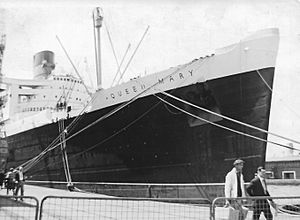
After the war, the Queen Mary was refitted to become a passenger ship again. It received air conditioning and updated cabins. The ship and its sister, the Queen Elizabeth, became very popular for transatlantic travel through the 1940s and 1950s.
However, in the late 1950s, commercial jet flights began crossing the Atlantic. This meant people could travel between London and New York in just 7-8 hours, instead of several days by ship. Demand for ocean travel dropped sharply. By the mid-1960s, the Queen Mary was old and losing money.
In 1967, Cunard decided to retire the Queen Mary. Many offers came in, and the City of Long Beach bought the ship to turn it into a restaurant, museum, and hotel. On October 31, 1967, the Queen Mary left Southampton for the last time. It sailed around Cape Horn and arrived in Long Beach on December 9, where it was permanently docked.
A New Life: Hotel and Museum
After arriving in Long Beach, the Queen Mary underwent a big transformation. Many parts of the ship below "C" deck were cleared out to make space for a new museum called the Living Sea Museum. This meant removing the boiler rooms, engine rooms, and other machinery. The empty fuel tanks were filled with mud to keep the ship stable.
The ship was repainted, and its funnels, which were old and worn, were replaced with new replicas. The goal was to turn the ship into a hotel, with many of its first- and second-class cabins becoming hotel rooms. The main lounges and dining rooms were converted into banquet halls and event spaces.
On May 8, 1971, the Queen Mary opened its doors to tourists. The Jacques Cousteau's Museum of the Sea opened later that year, though it eventually closed due to low visitor numbers. In 1972, the hotel opened its first guest rooms.
Over the years, different companies managed the Queen Mary. Jack Wrather, a local millionaire, took over in 1980 and even brought the huge Spruce Goose airplane to be displayed next to the ship. This attracted many more visitors. Later, the Walt Disney Company briefly owned the lease, but they eventually gave it up.
The Queen Mary faced financial challenges and even closed for a short time in 1992. However, it reopened in 1993 under new management. Since then, various groups have worked to maintain and restore the ship. In 2016, a company called Urban Commons took over the lease, planning major renovations and new developments around the ship.
Keeping the Queen Mary Safe
In 2017, a report showed that the ship needed a lot of repairs, with costs estimated at nearly $300 million. The hull and other parts were corroding. The City of Long Beach provided $23 million for urgent repairs.
By 2019, an engineer reported that the ship was in its worst condition in 25 years, with problems like sewage floods and peeling paint. City officials, however, said that significant work was being done. The ship's old lifeboats, which were rotting and dangerous, were removed.
In May 2020, the Queen Mary closed due to the COVID-19 pandemic. The company managing it went bankrupt, and the City of Long Beach took back control in June 2021. An engineering firm found that $23 million was needed for urgent safety repairs to prevent flooding or even capsizing. The city began these repairs, including plumbing, Wi-Fi, and restoring handrails.
The Queen Mary reopened for limited tours in December 2022 and fully opened to the public on April 1, 2023. Thanks to repairs and increased tourism, the ship made over $3.5 million in profits from April to December 2023. In 2024, it was added to the Historic Hotels of America registry. In 2025, the Queen Mary Heritage Foundation, a non-profit group, was given permission to raise money and carry out restoration projects on the ship's artwork and furnishings.
Talking to the World: The Radio Room
The Queen Mary's original radio room, where professional operators sent messages, was removed when the ship came to Long Beach. However, a new amateur radio room was created one deck above the old one. This room, with the call sign W6RO, uses some of the ship's old radio equipment for display.
Volunteers from a local amateur radio club staff the room during public hours. Other licensed amateur radio operators can also use the radios. In 2007, the room was renamed the Nate Brightman Radio Room, honoring Nate Brightman, who dedicated over forty years to the W6RO station and the Queen Mary.
Mysterious Stories: Alleged Hauntings
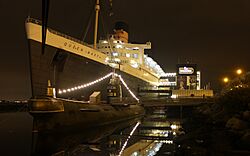
Since the Queen Mary docked in California, many stories have spread about the ship being haunted. These stories became popular in the 1980s. For example, Time magazine even listed the Queen Mary as one of the "Top 10 Haunted Places" in 2008.
Some legends say a young girl haunts the former second-class pool, or that a person's spirit haunts one of the staterooms. However, there are no official records to support these claims. Most deaths on the ship were from natural causes. Experts suggest that these stories might come from people's imaginations or from workers doing repetitive tasks.
Despite this, the Queen Mary offers "Haunted Encounters" and "Grey Ghost Project" tours. These tours focus on paranormal activity but also share facts from the ship's history, including records of documented deaths.
See also
 In Spanish: RMS Queen Mary para niños
In Spanish: RMS Queen Mary para niños


